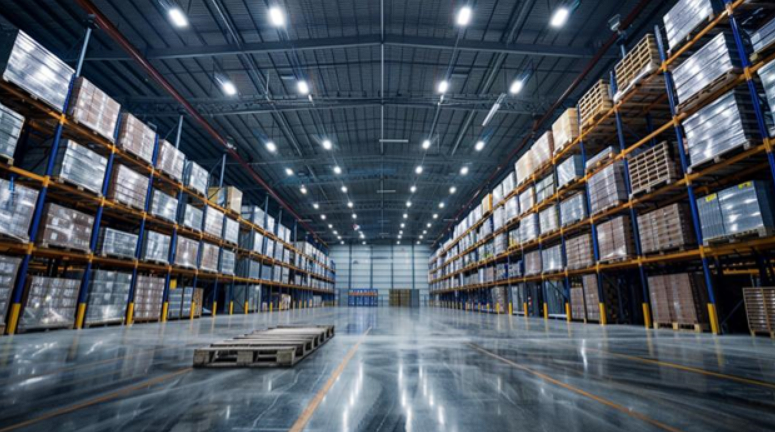Best Practices for Lighting Large-Scale Warehouse Spaces

Lighting a massive warehouse is trickier than it seems. I’ve walked dozens of warehouse floors, climbed under ceilings, and argued with electricians over light distribution.
Over time, I’ve picked up lessons, ones that theory doesn’t always teach you. In this guide to warehouse lighting, I’ll share what works, what trips people up, and how to choose the warehouse lighting contractor who’ll get it right (or not).
Lighting in a warehouse isn’t just about brightness. It’s about safety, productivity, cost, and even the mood of the space. Use the right lighting solution, and your facility hums. Use the wrong one, and you end up chasing dark spots, flickering fixtures, and angry staff. Let’s dig in.
Why Warehouse Lighting Matters More Than You Think

Imagine walking through a warehouse with hundreds of pallet racks, forklifts zipping about, and people picking orders. If the light is uneven, you risk accidents, mis-picks, slower work, and stress. I once visited a facility where one aisle had a “dead zone” so dim you needed a torch to see bar codes. They’d installed fixtures without thinking about even lighting or light distribution.
Lighting can account for a big slice of your energy bill in a warehouse. For example, Link Logistics reports that lighting represents 55% of power usage in their average facility, and by switching to LED or high-efficiency fixtures, they can cut power consumption by up to 50%. That’s huge. Also, one retrofit from metal halide to led light fixtures produced 73% energy savings in a warehouse case study.
So yes, the right fixture, layout, lighting controls, and lighting design are not optional extras. They can make or break your ROI.
Key Lighting Metrics & Standards (Don’t Skip This)

Before buying fixtures, you need to understand what numbers matter.
- Lumens: the total light output from a light source (fixture or bulb).
- Lux or foot-candles: how much light lands on a surface.
- Uniformity: ratio of brightest to darkest zones. If your spread is too uneven, you’ll get glare and shadows.
What do standards say a warehouse should aim for? For general storage and open areas, 300–500 lux is common, for zones needing inspection or detail work, maybe 750 lux or more.
Also, design guides suggest that for ceiling heights 20–30 ft, high bay fixtures rated ~22,000–35,000 lumens are good, ceilings 40+ ft need higher lumen outputs.
Don’t ignore lumen maintenance, even the best led light will lose output over time (L70 metrics).
With those benchmarks, you can judge whether a proposed light fixture is adequate, or overkill.
Choosing Technology & Fixtures Wisely
There’s no one “right” tech, but some are clearly better suited than others.

LED vs Legacy Technologies
Fluorescent lighting or fluorescent setups (T5, T8) were common. Metal halide was another. But these older fixtures often had high maintenance, slow start times, and poor efficiency.
Switching to led warehouse lighting is now the default. The best led light fixtures consume 60–80% less power than metal halide. In one warehouse, energy use dropped from ~88,784 kWh to ~45,501 kWh after upgrade. Another facility using a mix of LED + controls qualified for ~$30,000 in incentives.
NREL’s Commercial and Industrial Lighting Evaluation Protocol explicitly supports replacing metal halide high-bay fixtures with efficacious LED high-bay equipment, often in tandem with controls, to reduce energy use while maintaining required illuminance levels.
That said, if someone pushes you a “magic new tech,” ask for data. I once saw a “next-gen fixture” sold with claims of 90% savings, when real users got 30%. Always vet.
Fixture Types: High Bay, UFO, Linear, Low Bay
- High bay fixtures / high bay LED lights are for tall ceilings (20 ft+). The beam spreads light down to the floor.
- UFO high bay is a round, compact version. Good for narrower areas and easier mounting.
- Linear high bay can give more wider distribution along aisles.
- Low bay is for areas with lower ceilings (under ~20 ft).
- Bay light is sometimes used interchangeably, but generally high bay setups in large warehouses.
Pick high bay fixtures whose lumen output matches your ceiling height and spacing. As guidelines suggest, ceiling 20–30 ft → ~22,000–35,000 lumens per fixture.
Also consider color temperature — 4000K to 5000K is common in warehouses because it gives bright, crisp light that improves contrast, helping people spot labels or defects.
Finally, ensure IP ratings (for dust/moisture) and driver/ballast reliability.
Lighting Design and Layout Strategies
Design makes all the difference. Even tons of lumen output fail if placed poorly.
Zoning and Layering
Divide the warehouse into zones: general ambient, aisle/task lighting, accent lighting. Some zones may need more light (packing, inspection). Don’t light every square equally.
Spacing, Aiming, Beam Angles
Spacing is tied to lumen output and beam angle. You want slight overlap between fixtures, so no “dark trenches.” High ceilings may call for narrower beams, lower ceilings for wider.
Mounting height, aiming tilt, and beam adjustment matter. In racking aisles, you might tilt toward the racks to avoid floor glare.
Daylight & Daylight Harvesting
If your warehouse has skylights or clerestory windows, use daylight harvesting, dim or turn off fixtures when natural light suffices. This can yield 20–60% energy savings.
Smart Controls & Automation
Lighting controls like motion/occupancy sensors, dimming, zoning, and scheduling are no longer optional. In one facility, a retrofit with smart controls cut lighting energy by more than half.
Simulation studies show smart lighting systems in warehouses can reduce costs by ~40% to 60%, depending on layout and picker traffic patterns.
According to the GSA’s LED Lighting and Controls Guidance for Federal Buildings, controls and LED retrofits can yield significant lifecycle cost benefits — in their case studies, avoided maintenance value exceeded $1.00/ft², while avoided energy costs reached ~$3.50/ft².
Balancing Lighting Design Compromises
Don’t over illuminate just because fixtures are cheap. Overlighting wastes energy. Yet underlighting kills usability. You’ll sometimes accept tradeoffs, I had to reduce brightness a bit to avoid glare near docking doors. These decisions add character.
Energy Efficiency & Cost Saving — The Business Case
A warehouse is a business, not a lab. The lighting system must pay for itself.
Typical Savings & ROI
- Link Logistics: LED upgrades reduce ~50% of power usage in lighting.
- Prologis retrofitted 800,000 ft² facility, cut energy consumption by ~41%, saving ~$226,000 annually.
- Metal halide → LED switch gave 73% energy savings in one retrofit.
- In another warehouse, switching to smart lighting control saved nearly $15,000 in just 3 months.
- A warehouse cut its energy use nearly in half after switching to efficient fixtures + controls.
You should run a payback analysis: initial cost, incentives, expected energy cost reduction. Many projects pay back in 2–5 years, sometimes less.
Other Benefits
- Less maintenance: LED lifetimes often exceed 50,000+ hours.
- Better productivity: better light quality, fewer flickers, fewer mistakes.
- Safety improvements and reduced liability risk.
- Operational flexibility: use controls to shift light levels by time of day or zone.
These “soft” benefits are often selling points to decision makers.
Implementation & Project Planning
You can’t wing this. Experience (mine and yours) shows planning wins over impulse buys.
Audit & Survey First
Measure existing light levels, ceiling heights, power supply layout, rack layout, daylighting sources, and work patterns. That baseline is gold.
Specification and Photometric Planning
Demand photometric layouts (light maps) in proposals. Ask each warehouse lighting contractor candidate to show predicted lux uniformity maps, energy use, control scheme. Those who can’t, you have concerns.
Choosing a Contractor
Don’t just pick the lowest bid. Vet experience, past warehouse work, warranty, ability to integrate control systems, and references. I once sat in on a contractor’s pitch; they couldn’t explain how their control system tied to motion sensors — red flag.
Phasing & Installation
You may have to do zones one at a time to keep operations running. Stage installation during off-hours. Integrate wiring and control conduits. Test each zone.
Commissioning & Verification
After install, measure real lux, check uniformity, confirm control responses. Adjust aim, trim zones. Some contractors resist this, insist on it.
Operation, Maintenance & Continuous Improvement
Your job doesn’t end at “lights on.”
- Establish cleaning schedules (dust dims light).
- Track fixture failure or driver issues.
- Use the lighting system’s monitoring (if smart) to see dimming patterns, dark zones.
- Periodically revisit light levels as operations shift (racks change, usage evolves).
- Detect faults and replace them before full failure.
- Train staff: don’t let janitors “turn off zones” arbitrarily and break your system.
Future Trends & Innovations
What’s coming next? I’m excited, but also cautious.
- AI / adaptive lighting that watches human movement, anticipates zones to brighten/dim.
- IoT systems are achieving control and optimization that realize up to 80% energy savings in experiments.
- Human-centric lighting: shifting color temperature across shifts to support alertness or cool down.
- Wireless sensor nets (battery-less) that detect presence more reliably.
These are promising, but often immature. Pilot before full rollout.
Challenges & Pitfalls to Watch For
It’s not all smooth. From my experience:
- Overlighting in areas where you think “more is better” — wasteful.
- Dark pockets or glare from poor aiming.
- Vendors are pushing proprietary control systems that lock you in.
- Underestimating maintenance or replacement cycles.
- Ignoring power infrastructure (voltage drops, wiring) in planning.
- Failing to calibrate sensors, so the lights flick on/off annoyingly.
Be skeptical. Ask for field data. Trust but verify.
Summary & Takeaways
Lighting a large warehouse well is a crucial investment, not just a utility cost. Good lighting design, proper fixture selection, and smart lighting control systems lead to safer, more productive, and more cost-efficient operations. A solid warehouse lighting contractor can make the difference between success and costly regrets.
If you stick to these best practices, lean on data, and update your system over time, you’ll see returns not just in energy savings but in morale, accuracy, and smooth operations. At the end of the day, a warehouse is only as good as the visibility inside it.
When you apply the right combination of design, tech, and human insight, you get the right light in the right place, and that pays off.
More to love!
All the Unique Luxury Lighting Brands You Need to Know
5 Ways Flush Mount Lighting Can Enhance Small Spaces





